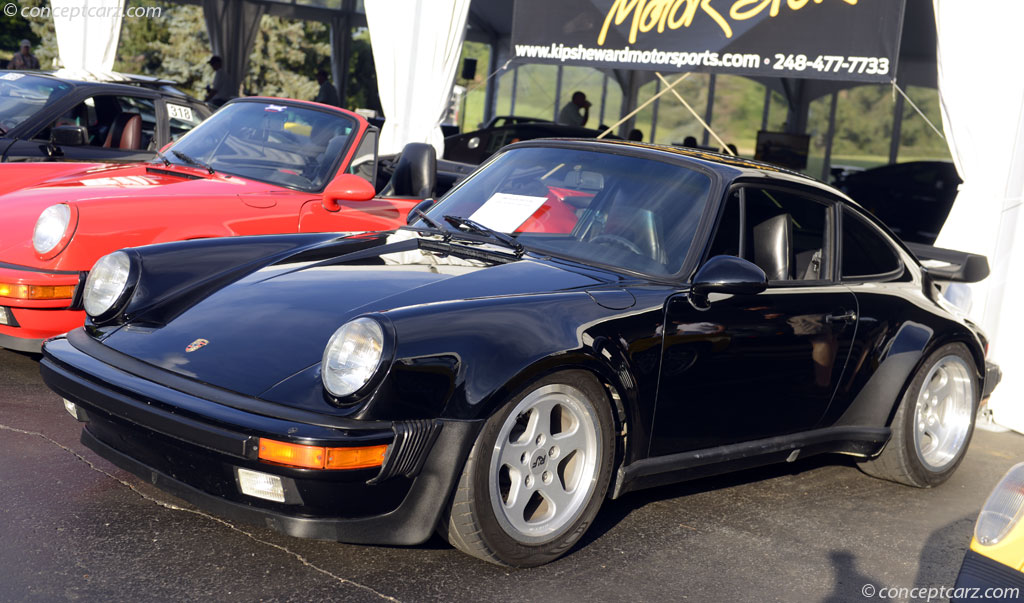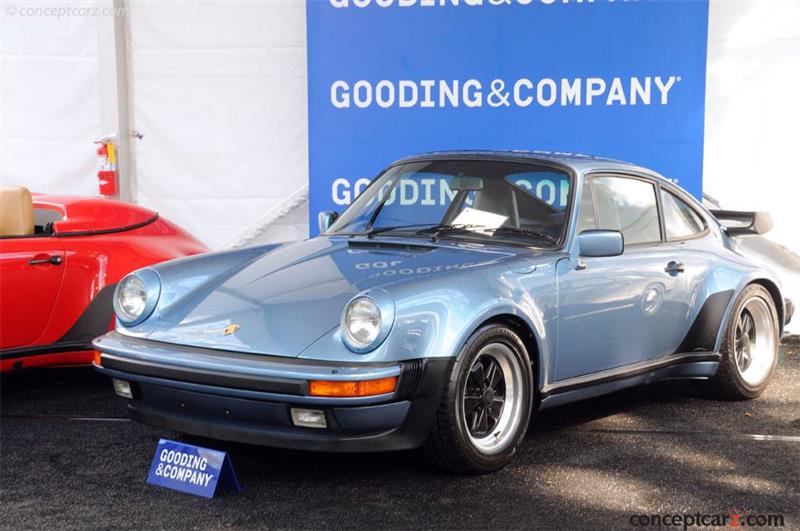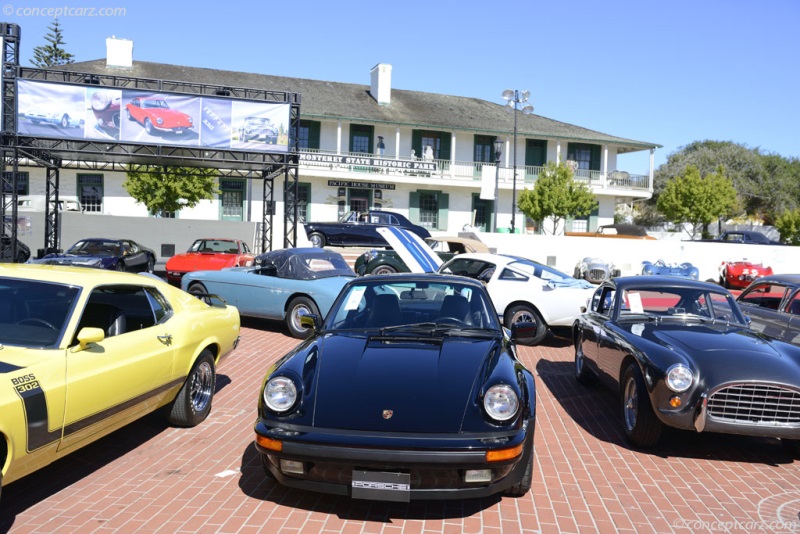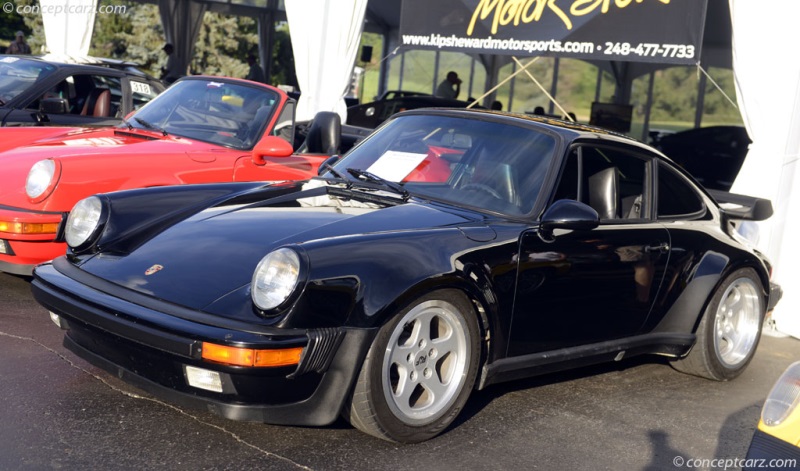Porsche gained a wealth of knowledge and experience with turbocharged air-cooled engines from its racing program, which was subsequently applied to its road-going, rear-engined sports car. As the world struggled during the early 1970s due to the fallout from the oil crisis, Porsche's turbocharged powerplants offered unrivaled performance and fuel economy. Porsche's experimentation with turbocharging technology began during the late 1960s. The prototype turbocharged 911, the Type 930, was introduced in 1973 at the Paris Motor Show. The 3.0-liter air-cooled flat-six engine had its origins dating back to the 911 RSR, and by attaching a KKK turbocharger, it was the most powerful production Porsche created thus far. The production-ready 911 Turbo was shown at the Paris show in the autumn of 1974, capturing the attention of the motoring press and the hearts of the consumers. As a high-performance, luxurious flagship model, it combined attractive styling, a potent powerplant, and creature comforts such as electric windows and air conditioning. Among the most noticeable features was the enormous 'whale-tail' spoiler and a wider track to contain the bulging wheels and tires. Production of the road-going 911 Turbo began in 1975, initially built to satisfy homologation requirements, but quickly gained popularity with enthusiasts. By the end of 1975, Porsche had built four-hundred examples of the 911 Turbo. The 1,000th 911 Turbo was completed on 5 May 1976.Group 4 and 5
The 911 Turbo Carrera RSR 2.1 raced under FIA's Appendix 'J' regulations for 1974, but for 1975 and 1976, the FIA announced that cars for Group 4 and Group 5 had to be production cars offered for sale through manufacturer dealer networks. A minimum of 400 cars were required to be built during a twenty-four-month period to gain approval for Group 4 racing during the 1976 season. Group 5 regulations stated the car had to be derived from a homologated model in Group 3 or 4. The Porsche 934 contested Group 4 (homologated in December of 1975) and the all-new 935 raced in the Group 5 category. Porsche 935
Porsche introduced a new design shape with the Porsche 935 which made its first appearance at Mugello in March of 1976 as it contested the 'World Championship of Makes' (essentially an international championship for long-distance Sports Car racing). These 'Flachbau' or 'Flatnose' 935s and 936s were very successful in the capable hands of Jacky Ickx, Jochen Mass, and Rolf Stommelen, and over the next two seasons captured four victories in eight World Championship races and a triumph at Le Mans in each year. Concurrently, privateers were investing their own money in conventionally shaped competition 911s, and Porsche worried that the factory Flatnose cars might alienate their clientele. Thus, the decision was made to restrict their efforts for 1978 to an entry at Le Mans. Flachbau
As is often the case, the innovations previewed on the racetrack make their way to the public through production cars. The styling of the 'Flachbau' (meaning 'Low Build') was iconic and memorable, and from 1985 until early 1989, Porsche 930 buyers could specify their car in this style to special order. These cars have become known as Flatnose, Slantnose or SE cars. The demand for the 'Flachbau' was initially catered for by 'Kremer Racing' who offered a conversion. Eventually, Porsche's Customer Department took over this service to special order (Sunderwunschen) from 1981, only becoming a factory option in 1986. Dubbed the 911 Turbo SE Flachbau, it carried a price tag that was twice as expensive as a standard 930 Turbo when new. Styling elements included the 935-style, sloping front end in steel with integrated cooling vents and 'pop-up' headlights. They had a dual exit exhaust system and an upgraded interior with pockets under both sides of the dashboard, a unique center console, steering wheel, heated front seats, and a gear lever knob with gold crests. The SE Flachbau was a fully bespoke, hand-built option that came equipped with an uprated engine of 330bhp, a limited-slip differential, and a sunroof.Due to the high premium price, only a limited number of Flachbau units were built. In later years Porsche supplied a works 'Flachbau kit' designed to be retrofitted to 930 Turbos. Specification
The Porsche 911 Turbo rested on an 89.4-inch wheelbase and stood 51.6 inches tall, was 69.9 inches wide, and had an overall length of 168.9 inches. Complimenting the higher specification engine was a revised suspension, an improved and stronger gearbox, and larger brakes. The wider rear wheels with upgraded tires helped deliver power to the road and improved the vehicle's grip. The 'whale tail' rear spoiler helped siphon more air to the engine and increased downforce to the rear of the vehicle. In 1978, the 'what tail' spoiler was re-profiled and raised to accommodate the addition of a new intercooler. This spoiler design is known by Porsche enthusiasts as the 'tea tray' spoiler. Engine output increased to nearly 300 horsepower in 1978, so Porsche made improvements to the brakes and suspension to cope with this change. The brakes were now similar to those used on the 917 race car, and the suspension received new anti-roll bars, larger diameter rear torsion bars, and firmer shock absorbers.
CoupeThe turbocharger originated from the 917/30 Can-Am project and was adapted by Ernst Fuhrmann for use on the 3.0-liter flat-six engine powering the Carrera RS 3.0. Internally, Porsche dubbed it the '930.' With the single KKK turbocharger installed and a higher compression ratio of 6.5:1, the engine produced 256 horsepower at 5,500 RPM and 243 (329 Nm) lb-ft of torque at 4,000 RPM. This output was much higher than that of the standard Carrera upon which it was based. For the 1978 model year, the engine bore was increased by 2mm resulting in a total displacement size of 3,299cc. An air-to-air intercooler was added to help cool the pressurized air charge, resulting in an increase of power to 296 hp (300 PS) at 5,500 RPM and 304 lb-ft (412 Nm) of torque at 4,000 RPM (DIN). Porsche offered a performance option for 1983 to the European market with increased the engine's output to 325 hp (330 PS) at 5,750 RPM and 320 lb-ft (432 Nm) of torque at 4,000 RPM. These so-called Werksleistungssteigerung (WLS, 'Works Performance Increase') were built-to-order and added an additional oil-cooler, a re-profiled front spoiler, additional ventilation holes in the rear fenders, a quad-pipe exhaust system, and modified rockers. Although the less-potent Carrera received a five-speed manual gearbox, the 930 Turbo used a four-speed transmission. A Getrag G50 five-speed manual transmission was used for the 1989 models, the final year of the 930. 930 Turbo in the U.S.
Exports to the United States began in 1976 but ceased (along with the Japanese exports) in 1980 due to changing emissions regulations. The Canadian and European markets, however, continued to receive the 930 Turbo. Following a six-year absence, the Type 930 returned to Porsches U.S. and Japanese lineup in 1986 and was once again their top-of-the-line 911. With the help of a new Bosch DMR engine management system and an oxygen sensor, the Type 93068 3.3-liter turbocharged and intercooled engine produced 282 horsepower at 5500 RPM and 278 lb-ft (377 Nm) of torque at 4,000 RPM. Zero-to-sixty mph was accomplished in 4.6 seconds and the top speed was nearly 160 mph. For 1986, a total of 1,424 U.S-specification 911 Turbos were built. Also in 1986, cabriolet and Targa versions of the 930 Turbo became available. Production
The 3.0-liter version of the Porsche 930 Turbo was built from 1975 to 1977 with 2,819 examples built. The 3.3-liter version was produced from 1978 to 1989 with 18,770 examples built.
by Daniel Vaughan | Nov 2022
The 911 Turbo Carrera RSR 2.1 raced under FIA's Appendix 'J' regulations for 1974, but for 1975 and 1976, the FIA announced that cars for Group 4 and Group 5 had to be production cars offered for sale through manufacturer dealer networks. A minimum of 400 cars were required to be built during a twenty-four-month period to gain approval for Group 4 racing during the 1976 season. Group 5 regulations stated the car had to be derived from a homologated model in Group 3 or 4. The Porsche 934 contested Group 4 (homologated in December of 1975) and the all-new 935 raced in the Group 5 category. Porsche 935
Porsche introduced a new design shape with the Porsche 935 which made its first appearance at Mugello in March of 1976 as it contested the 'World Championship of Makes' (essentially an international championship for long-distance Sports Car racing). These 'Flachbau' or 'Flatnose' 935s and 936s were very successful in the capable hands of Jacky Ickx, Jochen Mass, and Rolf Stommelen, and over the next two seasons captured four victories in eight World Championship races and a triumph at Le Mans in each year. Concurrently, privateers were investing their own money in conventionally shaped competition 911s, and Porsche worried that the factory Flatnose cars might alienate their clientele. Thus, the decision was made to restrict their efforts for 1978 to an entry at Le Mans. Flachbau
As is often the case, the innovations previewed on the racetrack make their way to the public through production cars. The styling of the 'Flachbau' (meaning 'Low Build') was iconic and memorable, and from 1985 until early 1989, Porsche 930 buyers could specify their car in this style to special order. These cars have become known as Flatnose, Slantnose or SE cars. The demand for the 'Flachbau' was initially catered for by 'Kremer Racing' who offered a conversion. Eventually, Porsche's Customer Department took over this service to special order (Sunderwunschen) from 1981, only becoming a factory option in 1986. Dubbed the 911 Turbo SE Flachbau, it carried a price tag that was twice as expensive as a standard 930 Turbo when new. Styling elements included the 935-style, sloping front end in steel with integrated cooling vents and 'pop-up' headlights. They had a dual exit exhaust system and an upgraded interior with pockets under both sides of the dashboard, a unique center console, steering wheel, heated front seats, and a gear lever knob with gold crests. The SE Flachbau was a fully bespoke, hand-built option that came equipped with an uprated engine of 330bhp, a limited-slip differential, and a sunroof.Due to the high premium price, only a limited number of Flachbau units were built. In later years Porsche supplied a works 'Flachbau kit' designed to be retrofitted to 930 Turbos. Specification
The Porsche 911 Turbo rested on an 89.4-inch wheelbase and stood 51.6 inches tall, was 69.9 inches wide, and had an overall length of 168.9 inches. Complimenting the higher specification engine was a revised suspension, an improved and stronger gearbox, and larger brakes. The wider rear wheels with upgraded tires helped deliver power to the road and improved the vehicle's grip. The 'whale tail' rear spoiler helped siphon more air to the engine and increased downforce to the rear of the vehicle. In 1978, the 'what tail' spoiler was re-profiled and raised to accommodate the addition of a new intercooler. This spoiler design is known by Porsche enthusiasts as the 'tea tray' spoiler. Engine output increased to nearly 300 horsepower in 1978, so Porsche made improvements to the brakes and suspension to cope with this change. The brakes were now similar to those used on the 917 race car, and the suspension received new anti-roll bars, larger diameter rear torsion bars, and firmer shock absorbers.
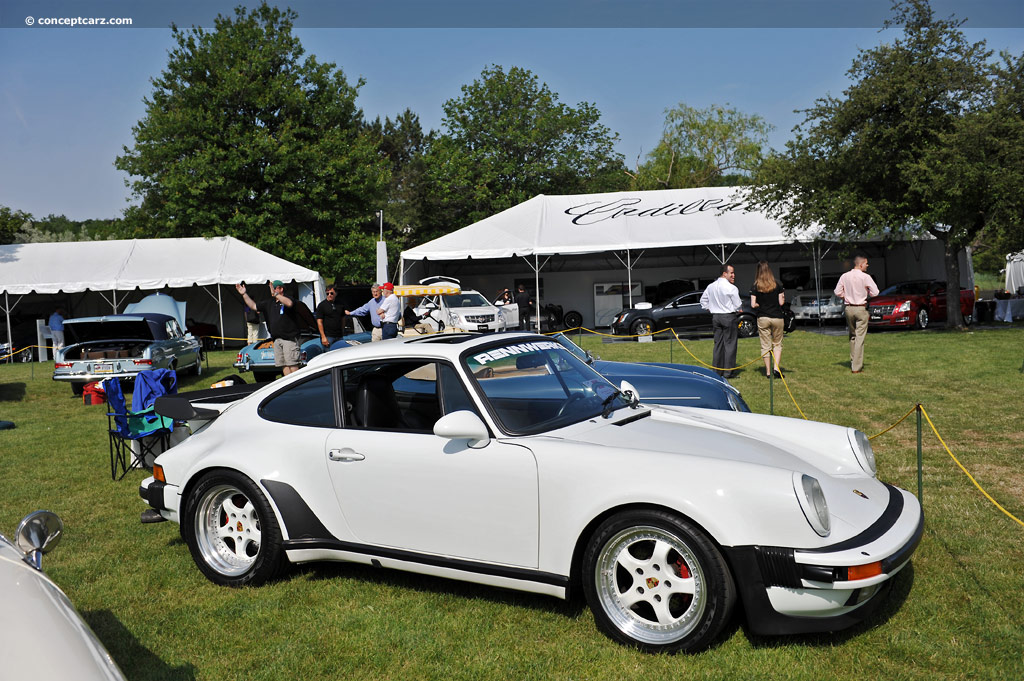
Coupe
Exports to the United States began in 1976 but ceased (along with the Japanese exports) in 1980 due to changing emissions regulations. The Canadian and European markets, however, continued to receive the 930 Turbo. Following a six-year absence, the Type 930 returned to Porsches U.S. and Japanese lineup in 1986 and was once again their top-of-the-line 911. With the help of a new Bosch DMR engine management system and an oxygen sensor, the Type 93068 3.3-liter turbocharged and intercooled engine produced 282 horsepower at 5500 RPM and 278 lb-ft (377 Nm) of torque at 4,000 RPM. Zero-to-sixty mph was accomplished in 4.6 seconds and the top speed was nearly 160 mph. For 1986, a total of 1,424 U.S-specification 911 Turbos were built. Also in 1986, cabriolet and Targa versions of the 930 Turbo became available. Production
The 3.0-liter version of the Porsche 930 Turbo was built from 1975 to 1977 with 2,819 examples built. The 3.3-liter version was produced from 1978 to 1989 with 18,770 examples built.
by Daniel Vaughan | Nov 2022
Related Reading : Porsche 911 History
The legendary Porsche 911 is the longest production run sports car of all time. It was conceived as a successor for the highly successful Porsche 356 and from the start had high aspirations for success. Ferry Porsches son, Ferdinand Alexander Porsche, designed the 911. When it went into production it was labeled the 901 but Peugeot had claims to the name, so to avoid infringing on their naming scheme,....
Continue Reading >>
Continue Reading >>
Related Reading : Porsche 911 History
Who could predict that the 911 would be Porsches saving grace and surpass the 356 in sales, longevity Quickly establishing itself as an icon of 60s cool, the iconic 911 only became more popular as the years went on. The flagship of the current lineup of Porsche, the 911 (pronounced Nine Eleven) or Neunelfer is a two-door grand tourer with a very distinctive design. The 911 is one of the oldest....
Continue Reading >>
Continue Reading >>
Similar Automakers
1986 Porsche 911 Turbo Vehicle Profiles
Recent Vehicle Additions
Performance and Specification Comparison
911 Carrera Specification Comparison by Year
Year
Production
Wheelbase
Engine
Prices
89.50 in.
89.50 in.
6 cyl., 193.10 CID., 214.00hp
6 cyl., 193.14 CID., 282.00hp
6 cyl., 193.14 CID., 282.00hp
$38,505 - $76,505
89.50 in.
6 cyl., 193.10 CID., 214.00hp
6 cyl., 201.32 CID., 282.00hp
6 cyl., 201.32 CID., 282.00hp
$38,500 - $76,500
89.40 in., 89.50 in.
6 cyl., 193.10 CID., 215.00hp
6 cyl., 201.30 CID., 282.00hp
6 cyl., 201.30 CID., 282.00hp
$51,200 - $85,100
89.50 in.
6 cyl., 193.10 CID., 215.00hp
6 cyl., 201.30 CID., 282.00hp
6 cyl., 201.30 CID., 282.00hp
$51,200 - $51,200
Related Automotive News

First RUF Class at Amelia Island Concours Celebrates RUF Automobile
Legendary supercar manufacturer RUF Automobile is pleased to be featured in a dedicated class at the 29th annual Amelia Island Concours dElegance this Sunday, March 3. It marks the first time RUF has had its own class at a concours. Fourteen RUF vehicles...

Singer Presents Dynamics & Lightweighting Study - Turbo
Singers latest restoration services offered to enthusiast owners of the Type 964 air-cooled 911
Turbocharging integrated with the results of the Dynamics %26 Lightweighting Study (DLS)
Personalized at the request of Singers clients for road or tr...

TIMEWARP 4,400-MILE 1985 PORSCHE 911 CARRERA 3.2 COUPE GOES ON SALE AT HEXAGON
Hexagon is proud to offer for sale one of the lowest mileage Porsche 911 Carrera 3.2 Coupes in the world
Incredible 1985 Garnet Red example has been perfectly preserved since birth and has just 4,429 miles on the clock
Carrera 3.2 was the last-of-...

INCREDIBLY RARE PORSCHE 964 TURBO ‘FLATNOSE' GOES ON SALE AT HEXAGON
Hexagon is proud to offer one of only 12 right-hand-drive 964 Turbos in rare Flatnose guise for sale
Flatnose models were produced by Porsche to mark the end of the 964s life, with just 76 made worldwide
Car at Hexagon has covered just 630 mile...

CHRYSLER GROUP IN 2015, UNDER THE HOOD: MORE POWER, GREATER EFFICIENCY AND EXCEPTIONAL VALUE
Introducing the HEMI® Hellcat – Chrysler Groups most powerful V-8 ever 18th new engine added to Company lineup in less than five years
Celebrated TorqueFlite family grows by one with most robust eight-speed automatic in Chrysler Group history 15...
